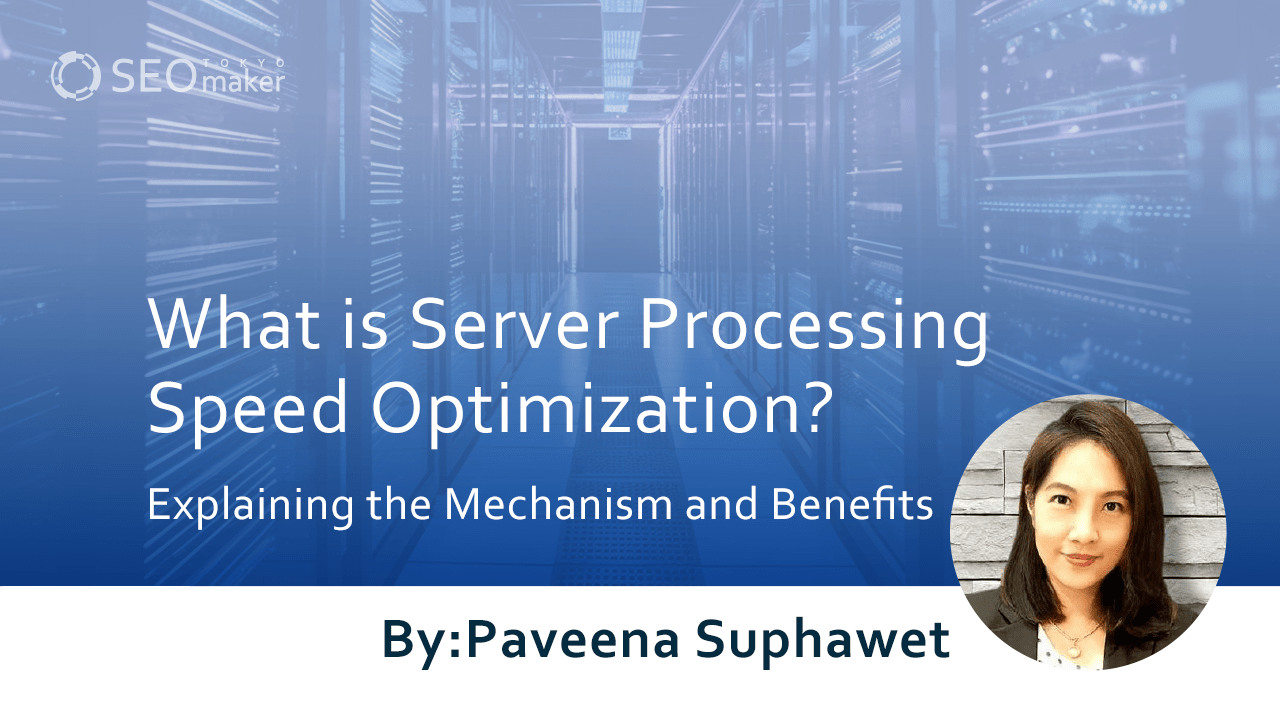What is Server Processing Speed Optimization? Explaining the Mechanism and Benefits
contents
- 1 What is Server Speed Optimization?
- 2 Benefits of Speeding Up Server Processing
- 3 Causes of Slow Server Processing
- 4 Methods to Speed Up Server Processing
- 5 Methods to Enhance Rendering Speed
- 6 Common Questions About Speeding Up Server Processing
 Server processing speed optimization is crucial for web operations, as any incident with the server can significantly impact a website. Therefore, knowledge about servers is indispensable for managing a website.
Server processing speed optimization is crucial for web operations, as any incident with the server can significantly impact a website. Therefore, knowledge about servers is indispensable for managing a website.
In this article, we will focus on server processing speed optimization. Tokyo SEO Maker, an SEO specialist media, will explain this topic in an easy-to-understand manner.
What is Server Speed Optimization?
Server speed optimization involves enhancing the server’s processing speed by optimizing its hardware specifications and organizing server data.
The Mechanism of Servers and Websites
A server in the web context is a cloud-based space for storing data. Websites and pages are opened through data transmission between the server and the user’s device (web browser). This process involves the interaction of front-end and back-end areas, displaying the website. Any delay in server-side data processing can hinder the smooth use of websites and pages.
Front-End
The front-end refers to the part of a website or page that site visitors directly interact with. For example, article texts, image data, and comment posting buttons are part of the front-end. The languages covering the front-end include HTML, CSS, and JavaScript.
Back-End
The back-end refers to areas like internal systems and databases that site visitors do not directly interact with. It includes the data processing and systems required for functionalities like posting comments. Programming languages managing the back-end include PHP, Python, and Java.
Benefits of Speeding Up Server Processing
Optimizing server processing offers benefits such as improved web page display speed and the ability to handle numerous simultaneous accesses.
Improved Web Page Display Speed
Faster server processing enhances the display speed of web pages on the visitor’s device. Typically, if a web page takes more than 3 seconds to display, the bounce rate significantly increases. This delay can negatively impact SEO (Search Engine Optimization).
Handling Multiple Simultaneous Accesses
Improved server processing speed allows handling numerous simultaneous accesses. Each access triggers data processing on the server, increasing the load with more connections. Rapid access increases due to trends can strain servers with limited processing capacity, affecting usability.
Causes of Slow Server Processing
Several factors can cause slow server processing, including low server specs, unoptimized programs and markup, large image file sizes, and database management issues.
Low Server Specs
Low-performance servers can slow down processing speeds. Aging servers not only become slower but also pose a risk of sudden failure.
Unoptimized Programs and Markup
Unorganized source code for website construction can increase unnecessary code loading and data transmission, slowing down page display.
Large Image File Sizes
Large file sizes increase data transmission, adding to the server load. Image data, a significant part of web page content, can substantially increase overall data volume.
Database Management Issues
Improper database management can significantly impact server processing. Issues include excessive SQL language, storing unnecessary data, and inappropriate index settings.
Methods to Speed Up Server Processing
There are several ways to accelerate server processing, including:
- Upgrading server specifications
- Utilizing server cache functions
- Streamlining source code
- Lightening files
- Optimizing database management
Upgrading Server Specifications
Enhancing the physical performance of server specifications can increase processing speed.
This can be achieved through:
- Replacing with a new server
- Increasing the number of servers
- Using a CDN (Content Delivery Network)
Note that a CDN is a technique to reduce the load on your company’s server by utilizing external servers on the internet.
However, these methods can increase costs and operational efforts. Consider these factors before deciding.
Utilizing Server Cache Functions
Servers are equipped with cache functions. Utilizing this feature can reduce the server processing load.
Server caching temporarily stores parts of website or page data on the server. This allows for quicker data loading during subsequent accesses, thus enhancing server processing speed.
Streamlining Source Code
Streamlining source code can reduce server load. Key areas to review include:
- Reducing the number of files to load
- Decreasing the file size of source codes
Reducing the Number of Files to Load
Reducing the number of files a server needs to load can enhance its processing speed.
When a site visitor opens a page, the server is accessed, and the corresponding HTML file is loaded. This HTML file contains instructions to load external files. The more external files to load, the more communication occurs with the server.
Thus, having unnecessary external files increases the server processing load.
Decreasing the File Size of Source Codes
Reducing the file size of each source code can lessen the server’s burden.
Therefore, it’s necessary to check for unnecessary or inefficient code. If you find code that is redundant, remove it to simplify the source code. However, be careful not to accidentally delete essential code.
Lightening Files
Lightening various files can reduce the server load. Especially on websites, compressing large image data is crucial. This process is known as image optimization.
For image optimization, review the following elements:
- File size
- Image size
- Resolution
- Image format
Optimizing Database Management
Optimizing database management can improve server processing speed. Inappropriate database settings can heavily burden the server, so pay special attention.
- Streamlining SQL language
- Avoiding unnecessary data storage
- Revising index settings
Streamlining SQL Language
If there are issues with SQL language descriptions, organize the code for improvement.
SQL is a computer language used for database management. Like programming language source code, incorrect or inappropriate SQL descriptions can negatively impact data processing.
Avoiding Unnecessary Data Storage
Databases can store various data. However, storing too much data can burden the server, leading to slower processing speeds. Avoid storing the following data in databases:
- Image data
- Session data
The former can be large and strain the database. The latter, session data, refers to communication data from when a site visitor accesses a page until they leave. This data is frequently updated and tends to grow quickly.
Revising Index Settings
Revising index settings can make data searches more efficient, leading to improved server processing.
An index in a database is a reference used when searching for data within the database. By marking data in the database, you can efficiently locate the desired data.
Methods to Enhance Rendering Speed
Rendering speed refers to the velocity at which content is displayed in a browser on a device.
To increase rendering speed, it’s not only about speeding up server processing but also employing techniques like:
- Utilizing browser cache functions
- Adopting Lazy Load
Using Browser Cache Functions
Using the cache function in a device’s browser can enhance the display speed of web pages. In this case, the cache is stored in the browser, meaning it specifically benefits visitors who access the same page on the same device.
Adopting Lazy Load
Lazy Load is a technique that delays the loading of image data. For instance, when a site visitor accesses a page, the web page initially loads and displays content. By implementing Lazy Load, the loading of images beyond the first view is delayed, enhancing the page display speed.
As the visitor scrolls through the device screen, images are sequentially rendered.
Common Questions About Speeding Up Server Processing
Here are some frequently asked questions about server processing acceleration, formatted as FAQs:
Q: When writing HTML, what should be considered to improve page display speed?
A: Overloading the head tag with too many loading elements can slow down page display speed. For example, JavaScript for web page access measurement is often written in the head tag. However, cramming all loading elements into the head tag impacts page display speed. Therefore, at Tokyo SEO Maker (this site), JavaScript is distributed and written both in the head tag and the body tag.
Q: What should be done on the frontend to accelerate server processing?
A: The following two actions are recommended:Reduce the number of communications with the server.Decrease the amount of data communicated to the server.
Q: What should be done on the backend to accelerate server processing?
A: Aim to increase the speed of data transmission from the server to the browser. This can be achieved through methods such as:
- Enhancing server specifications.
- Lightening various data sizes.
- Utilizing cache.
- Organizing data in the database.
- Streamlining programming code.
Q: What are some recommended rental servers in Japan?
A: Popular rental servers include:
Consider the functionality and cost that your company requires when deciding which rental server to use.
Summary
By accelerating server processing speed, a website can positively impact SEO and user experience. Conversely, extreme delays can compromise the website’s functionality. If server processing issues are identified, it’s crucial to determine the cause and implement corrective measures. These issues can stem from both frontend and backend aspects. Therefore, those responsible should deepen their understanding of server-related knowledge to be prepared for such challenges.























